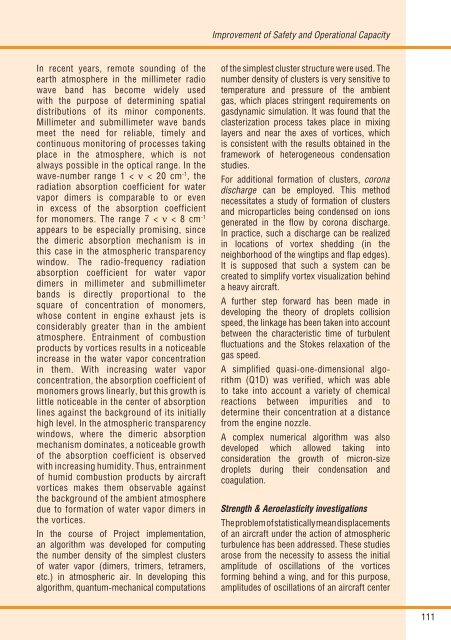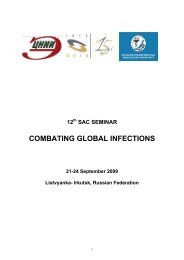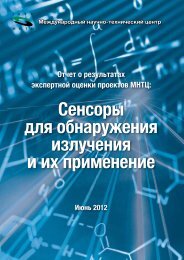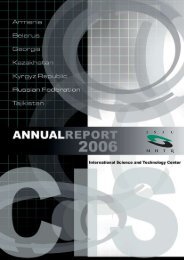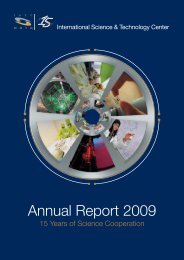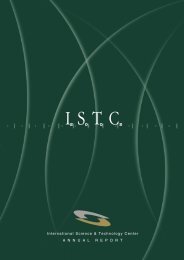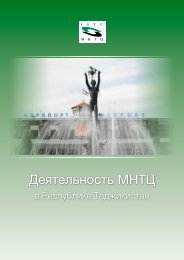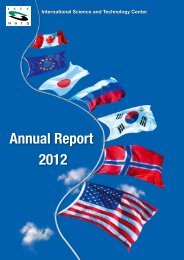Aerospace Research - ISTC Funded Projects 1994-2009
Aerospace Research - ISTC Funded Projects 1994-2009
Aerospace Research - ISTC Funded Projects 1994-2009
Create successful ePaper yourself
Turn your PDF publications into a flip-book with our unique Google optimized e-Paper software.
In recent years, remote sounding of the<br />
earth atmosphere in the millimeter radio<br />
wave band has become widely used<br />
with the purpose of determining spatial<br />
distributions of its minor components.<br />
Millimeter and submillimeter wave bands<br />
meet the need for reliable, timely and<br />
continuous monitoring of processes taking<br />
place in the atmosphere, which is not<br />
always possible in the optical range. In the<br />
wavenumber range 1 < ν < 20 cm 1 , the<br />
radiation absorption coefficient for water<br />
vapor dimers is comparable to or even<br />
in excess of the absorption coefficient<br />
for monomers. The range 7 < ν < 8 cm 1<br />
appears to be especially promising, since<br />
the dimeric absorption mechanism is in<br />
this case in the atmospheric transparency<br />
window. The radiofrequency radiation<br />
absorption coefficient for water vapor<br />
dimers in millimeter and submillimeter<br />
bands is directly proportional to the<br />
square of concentration of monomers,<br />
whose content in engine exhaust jets is<br />
considerably greater than in the ambient<br />
atmosphere. Entrainment of combustion<br />
products by vortices results in a noticeable<br />
increase in the water vapor concentration<br />
in them. With increasing water vapor<br />
concentration, the absorption coefficient of<br />
monomers grows linearly, but this growth is<br />
little noticeable in the center of absorption<br />
lines against the background of its initially<br />
high level. In the atmospheric transparency<br />
windows, where the dimeric absorption<br />
mechanism dominates, a noticeable growth<br />
of the absorption coefficient is observed<br />
with increasing humidity. Thus, entrainment<br />
of humid combustion products by aircraft<br />
vortices makes them observable against<br />
the background of the ambient atmosphere<br />
due to formation of water vapor dimers in<br />
the vortices.<br />
In the course of Project implementation,<br />
an algorithm was developed for computing<br />
the number density of the simplest clusters<br />
of water vapor (dimers, trimers, tetramers,<br />
etc.) in atmospheric air. In developing this<br />
algorithm, quantummechanical computations<br />
Improvement of Safety and Operational Capacity<br />
of the simplest cluster structure were used. The<br />
number density of clusters is very sensitive to<br />
temperature and pressure of the ambient<br />
gas, which places stringent requirements on<br />
gasdynamic simulation. It was found that the<br />
clasterization process takes place in mixing<br />
layers and near the axes of vortices, which<br />
is consistent with the results obtained in the<br />
framework of heterogeneous condensation<br />
studies.<br />
For additional formation of clusters, corona<br />
discharge can be employed. This method<br />
necessitates a study of formation of clusters<br />
and microparticles being condensed on ions<br />
generated in the flow by corona discharge.<br />
In practice, such a discharge can be realized<br />
in locations of vortex shedding (in the<br />
neighborhood of the wingtips and flap edges).<br />
It is supposed that such a system can be<br />
created to simplify vortex visualization behind<br />
a heavy aircraft.<br />
A further step forward has been made in<br />
developing the theory of droplets collision<br />
speed, the linkage has been taken into account<br />
between the characteristic time of turbulent<br />
fluctuations and the Stokes relaxation of the<br />
gas speed.<br />
A simplified quasionedimensional algorithm<br />
(Q1D) was verified, which was able<br />
to take into account a variety of chemical<br />
reactions between impurities and to<br />
determine their concentration at a distance<br />
from the engine nozzle.<br />
A complex numerical algorithm was also<br />
developed which allowed taking into<br />
consideration the growth of micronsize<br />
droplets during their condensation and<br />
coagulation.<br />
Strength & Aeroelasticity investigations<br />
The problem of statistically mean displacements<br />
of an aircraft under the action of atmospheric<br />
turbulence has been addressed. These studies<br />
arose from the necessity to assess the initial<br />
amplitude of oscillations of the vortices<br />
forming behind a wing, and for this purpose,<br />
amplitudes of oscillations of an aircraft center<br />
111


